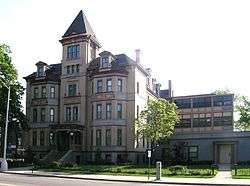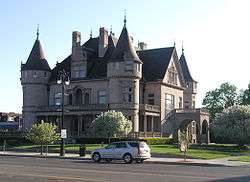Thompson Home
The Thompson Home is a Victorian structure located at 4756 Cass Avenue in Midtown Detroit, Michigan. Originally the Thompson Home for Old Ladies, it was constructed in 1884,[3] designated a Michigan State Historic Site in 1974,[2] and listed on the National Register of Historic Places in 1976.[1]
Thompson Home | |
 Thompson Home from across Cass | |
| Location | 4756 Cass Avenue Detroit, Michigan |
|---|---|
| Coordinates | 42°21′18″N 83°3′57″W |
| Built | 1884 |
| Architect | Mason & Rice |
| Architectural style | Victorian |
| Part of | Warren-Prentis Historic District (ID97001477) |
| NRHP reference No. | 76001041[1] |
| Significant dates | |
| Added to NRHP | June 03, 1976 |
| Designated CP | December 01, 1997 |
| Designated MSHS | November 14, 1974[2] |
History
David Thompson, a wealthy Detroit businessman, died in the early 1870s, leaving his estate to his wife Mary with instructions to establish a charitable institution.[4] In 1874, Mary Thompson allocated $10,000 to build a home for aged women. However, construction did not start until nearly ten years later when land was purchased and Mary commissioned George D. Mason of the firm Mason & Rice to design the home.[4][5]
Mason designed a four-story home measuring 60 by 90 feet with private rooms for forty women. For a number of years, the Thompson Home was a prestigious retirement home for wealthy widows.[4] Sun rooms were added to the original structure in 1914, living quarters for the staff were added in the 1950s, and a five-bed infirmary was constructed in 1964.[4] However, the number of residents declined in the 1960s and 1970s, and the home closed in 1977. Wayne State University bought the building and remodeled it, and in 1980 WSU's School of Social Work was installed in the building.[4] In 2015, the School of Social Work relocated. The building was then converted into housing for students from the College of Fine, Performing and Communication Arts, reopening in Fall of 2017 after an extensive renovation.[6]
Architecture
The four-story home is Queen Anne in style.[4] The front façade is dominated by an 80-foot tower, on either side of which bay window protrude. The windows are symmetric about the front, and a large stone carrying the building's name is set between the second and third floor. Artistic brickwork and painted bandcourses finish the exterior.[4]
References
- "National Register Information System". National Register of Historic Places. National Park Service. April 15, 2008.
- "Thompson Home for Old Ladies". Michigan State Housing Development Authority. Archived from the original on May 17, 2012. Retrieved September 2, 2010.
- Thompson Home for Old Ladies Archived 2007-10-11 at the Wayback Machine from the city of Detroit
- Thompson Home for Old Ladies from Detroit1701.org
- http://quod.lib.umich.edu/d/dpa1ic/x-dpa3469/dpa3469___tif
- http://cfpca.wayne.edu/news/open-fall-2017-for-residency-the-thompson-home-21914
Further reading
- Hill, Eric J. and John Gallagher (2002). AIA Detroit: The American Institute of Architects Guide to Detroit Architecture. Wayne State University Press. ISBN 0-8143-3120-3.
- Sobocinski, Melanie Grunow (2005). Detroit and Rome: building on the past. Regents of the University of Michigan. ISBN 0-933691-09-2.


